Driving tips – Driving in the rain.
Driving in the rain is necessary at times. When possible, drivers should avoid driving in conditions that are more likely to cause problems, but if you do have to drive in the rain, here are some valuable tips…
Driving in the rain with learners.
Learners 0-10 hours experience – not recommended. Learner drivers with less than 10 hours actual driving experience behind the wheel, should not attempt to drive in wet weather unless with an instructor in a dual controlled vehicle.Learners 11-20 hours experience – light rain, driving in back streets, daylight hours only.Learners 21-40 Hours experience – light rain, light traffic areas, daylight hours only.Learners 41-60 hours experience – light to moderate rain, light to moderate traffic areas, daylight hours only.Learners 61-80 hours experience – moderate to heavy rain, moderate traffic, dawn till dusk.Learners 81-100 hours experience – ONLY if you have had at least 2 hours experience driving in the rain – moderate to heavy rain, moderate traffic conditions, day and night.Drivers who have not had experience driving in heavy rain during the day, should not attempt to drive in heavy rain at night. Your crash risk is much higher driving in wet conditions at night.
Driving in the wet – Red P-Plates
You will expect to need all of your concentration to drive in wet conditions, so please do not get distracted by phones, friends, or even music in the car. You no longer have anyone sitting next to you to help or advice when you need it.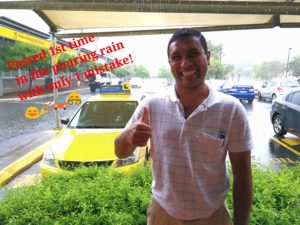
Driving in the wet – all drivers.
Slippery roads.
If it hasn’t rained for a period of time, you should expect the roads to be extra slippery when the rain finally does come down. There have been vehicle dropping engine oil and grease on the roads, and until that has been washed away, the is a very high crash risk.
Headlights
Please use your headlights when driving in moderate to heavy rain. Parking lights are not bright enough, and running lights whilst good in daylight, are not appropriate for low viability conditions.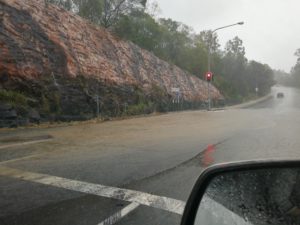
Allow more time for your trip in wet weather.
Apart from the fact most drivers slow their speed in wet conditions, you should expect to see more vehicles on the road – think of the many people who are normally happy to commute using public transport, but when they see bad weather, decide to take their cars instead. Expect delays, and don’t allow these issues to upset you.
Demister and wipers.
Do not start driving until you know how to use you demister (front and rear) and wipers. You do not want to be distracted trying to find the controls when driving in the wet.
Watch for pedestrians and cyclists.
There can often be extra pedestrian traffic in busy areas – shopping centers, schools etc so be aware that they can suddenly run across the roads in an effort to get out of the rain. Cyclists may also do unusual movements, so keep scanning your driving surrounds.
Large vehicles.
When driving in front of large vehicles – buses and trucks, please be aware they will need extra stopping distance – do not immediately lane change in front of them, and never slam on your brakes with a large vehicle behind you.
Traction control.
If you have traction or stability control in you car, please turn it on to assist with driving in the wet.
Puddles.
Driving on anything that isn’t road can be dangerous, most especially puddles. It is impossible to judge how deep a puddle is, and there is a good chance that the puddle has a pothole hidden in it’s depths. There is also the chance of damage being done to your engine and electrical parts if you are going through puddles big enough to cause a wave on the side of you car. Unless you see the vehicle in front of you safely navigate the puddle, do not attempt to go through it.
Brake earlier.
You must get in to the habit of braking earlier when driving in the rain. You are more likely to lose control of your vehicle in the wet, so breaking earlier and more smoothly that dry conditions will dramatically decrease your chance of skidding.
Poor visibility.
Do not attempt to drive in wet weather if you are having difficulty seeing the vehicles in front or the edges of your road.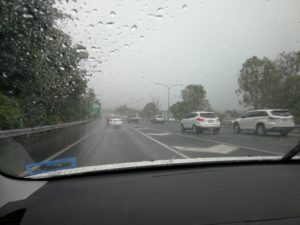 Find a safe area to pull over (always to the left of the roadway), keep your headlights on, and if necessary apply you hazard lights.
Find a safe area to pull over (always to the left of the roadway), keep your headlights on, and if necessary apply you hazard lights.
Stay Safe always.
All of us are trying to get to our destinations safely. Please, stay calm, and stay alert, follow the road rules, and everybody will get home to their loved ones.
Holiday driving
Make it fun!!!
Travelling with the family can be a great adventure! But make sure you arrive safe and sound.
Don’t allow the driver to be distracted – kids, you must keep the driver hydrated and happy.
Passenger: Shotgun – check all lights are working, give the car some cool driving songs, you are the back up driver so keep watch!
Passengers: rear seats – either: eye spy or hold intelligent conversations to keep the driver alert. Alternate choices include; singalong, reading books, thumb wars.
Above all, please, follow the road rules, prepare for the journey – know your route and make sure your car is roadworthy.
Let’s all work together to get to our destinations safely!
With your sense of humour (and driving adventure) intact.
Stop signs
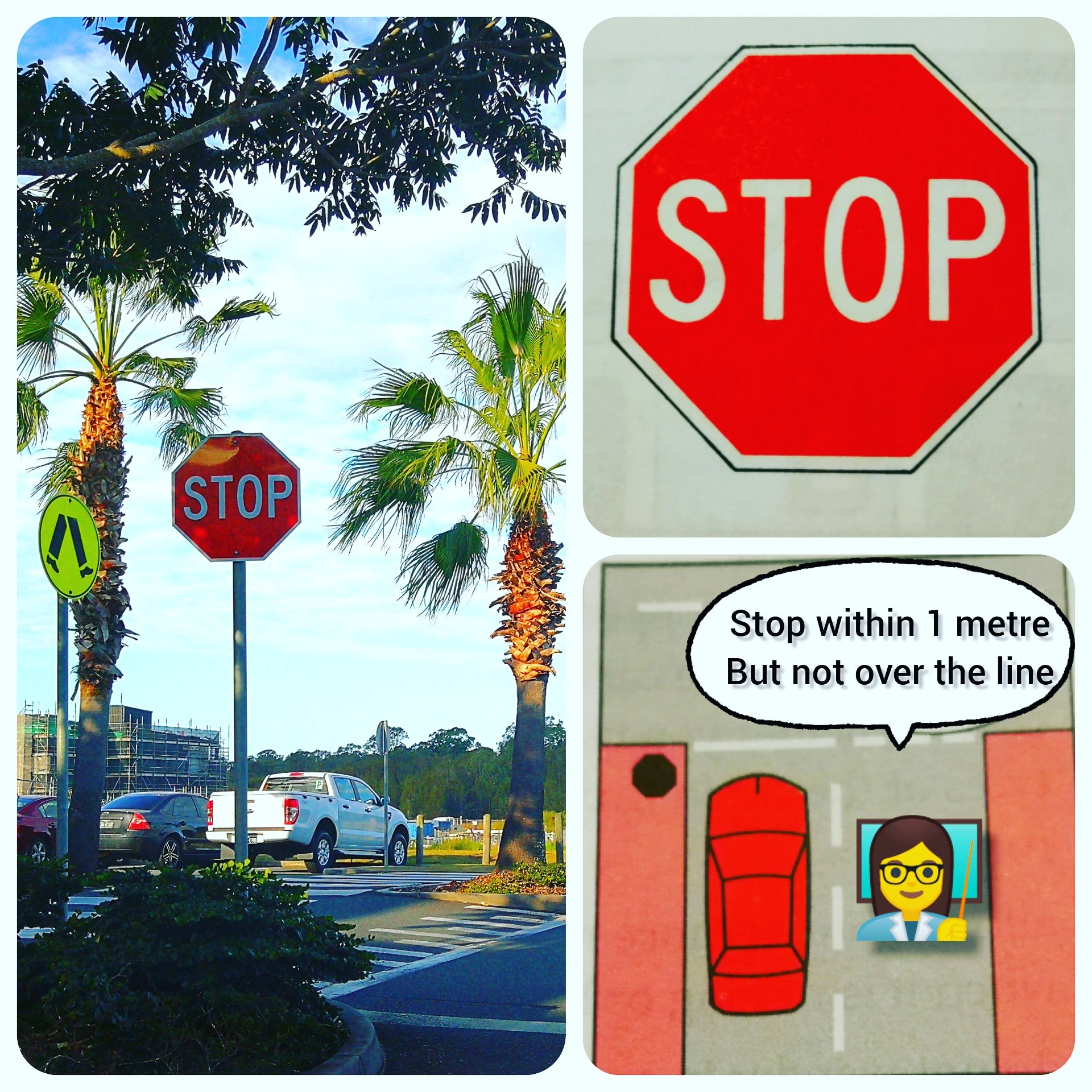 Stop 🛑 Does it really mean stop?
Stop 🛑 Does it really mean stop?
Do we count to 3 seconds?
Where do we stop the car – at the sign or at the line?
These are very common questions learners (and many experienced drivers) have. 🤔
Let me clarify for you!👩🏫🚘👍
🛑
If you are facing a stop sign, you must bring your vehicle to a COMPLETE STOP at the stop line. If there is no line on the road, you must stop as close as you can to the intersection.
🛑
If there is a car in front of you stopped at the line, then you must stop again when you reach the sign. 🛑
If you have stopped correctly at the stop line, but cannot see the traffic clearly, you may creep forward to get better visibility. But you must stop completely first.
🛑
Your vehicle should be as close as possible to the line, without being over the line, when you first come to a stop.
🛑
🤷♀️
I would also like to say that nowhere in the traffic act (Road rules) have I seen mention of stopping for 3 seconds! It takes 1 second to stop, but make sure you you do halt all movement on your tyres!
👩🏫
My personal tip for stop signs…. As you are approaching the line, look straight ahead until you feel the car stop, THEN check for traffic!
Give way
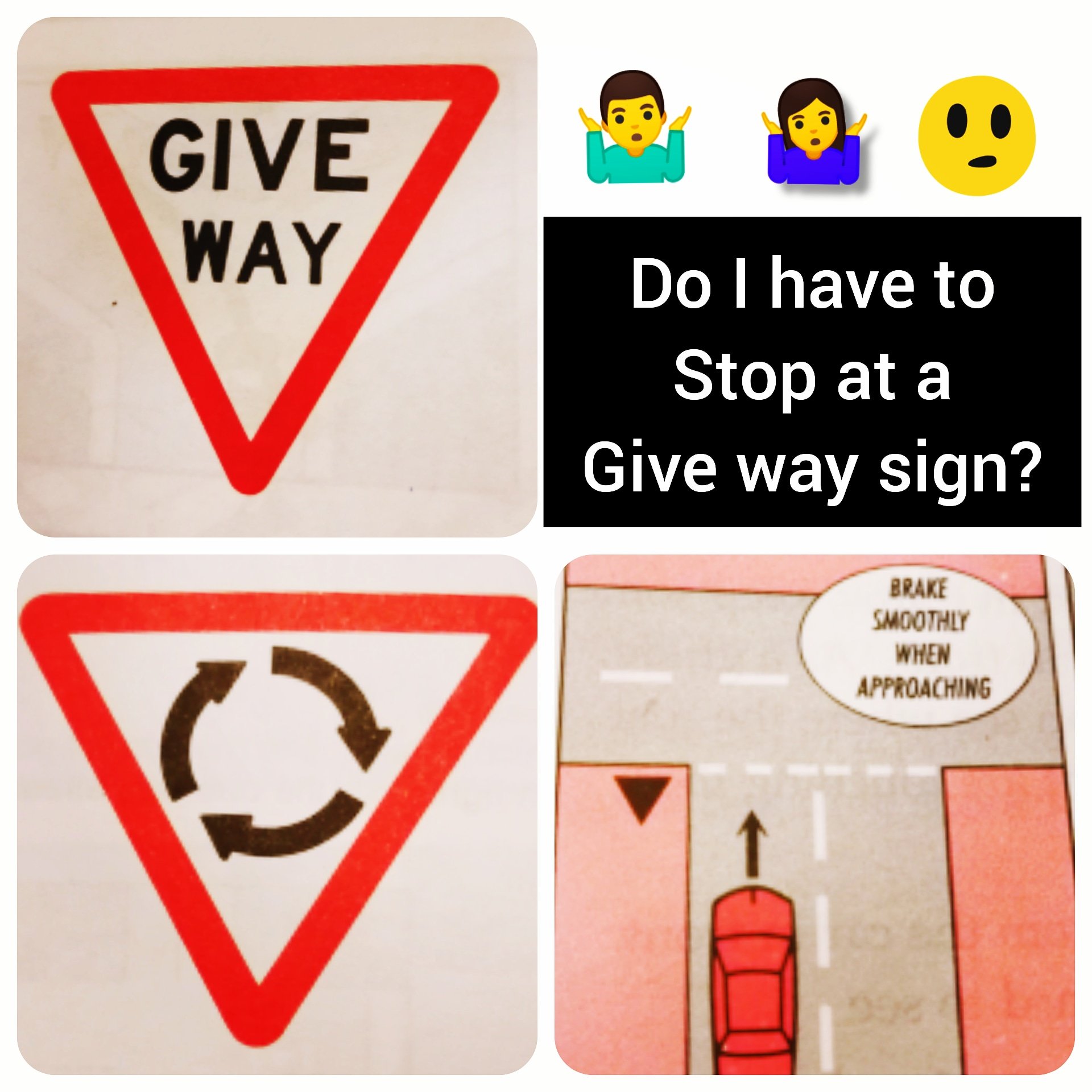 😁😊👍Give way 🚗Do I have to stop 🛑? When should I go? How far away should the car be before I can pull into the lane?
😁😊👍Give way 🚗Do I have to stop 🛑? When should I go? How far away should the car be before I can pull into the lane?
More common questions asked by learners 🤔
Let me clarify for you 👩🏫🚘👍
As you are approaching a give way sign or line, you must be PREPARED to stop, but if you are not going to disturb the approaching traffic, you may enter the lane way.
🚘
To enter or cross traffic safely, and without hesitation, you must have good control of the vehicle, and you should have developed good judgment.
🚘
If you go when oncoming vehicles are too close, it could be dangerous. However, if you are over cautious, you could delay traffic.
🚘
You must be braking enough on approach, with enough control to be able to stop smoothly if needed.
🚘
My tip: Give way means BE READY to stop 🛑 not stop every time.
👩🏫🚘👍
I have plenty more tips for stop and other regulatory signs, but for that, you will need to book a lesson😉 😃👏🚘
Merging
Signalling, indicating, blinkers, hand signals ✋🚘🙏 whatever you choose to call it, we need to understand when to use them correctly! 🚗🤷♂️🤷♀️
You must give other road users notice of your intention to change your path.
👥
A driver must give change of direction signal long enough to give sufficient warning to other drivers and pedestrians.
⚠️
You are considered to changing directions if:
You are moving more than 1 metre to the left or right of your path – including
Turning left
Turning right
Lane changing
Merging
Diverging
Entering a marked lane (turn bays)
At a T-intersection where road markings are missing or could confuse other road users if you fail to indicate.
🚘
If you are moving from a stationery position (pulling out from the kerb, pulling out of a driveway etc) you must give 5 seconds notice before moving.
✋👆👈👉
Hand signals are rarely used these days, unless you have a fault with the vehicle or you need to give extra notification. 👩🏫🚗👍
My tips – indicate AT LEAST 30 metres before a corner.
The faster you go – the earlier you indicate. I would rather see drivers indicate too early rather than too late!
👀
I am amazed by the amount of drivers who must think we have mind reading abilities! It only takes a flick of 1 finger to use your indicators, please use them correctly.
🙏🙏🙏
COMMUNICATE!!! Let other road users know what you are doing, and I guarantee you will have less problems on the roads!
🚗 Happy and safe driving everyone! Liz.

